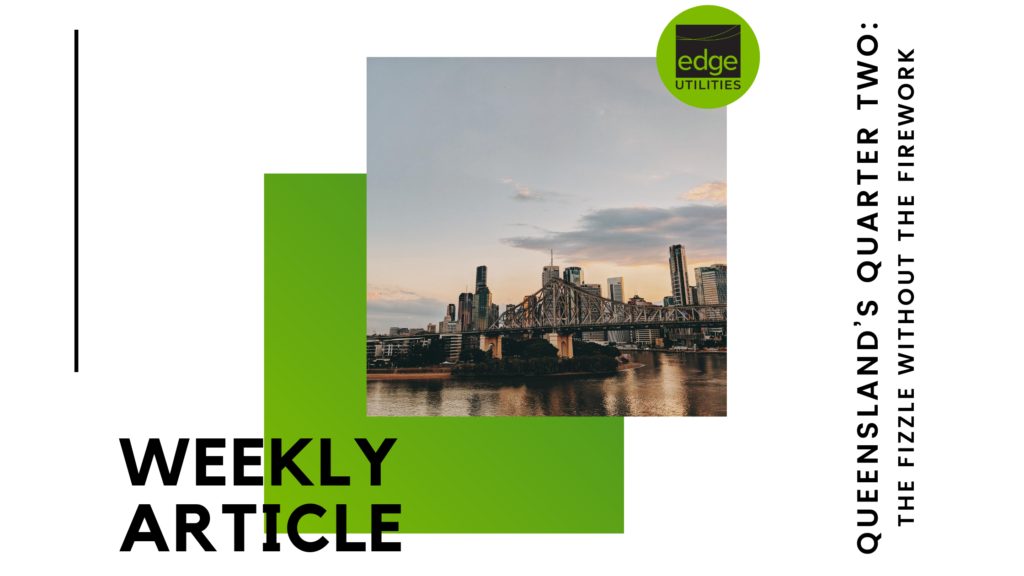In the first quarter of 2020 (Q120), the Queensland average spot price dropped to its lowest levels since Q116 averaging $54/MWh. The market sentiment was that the generators were already running at, or just above losses and this could not be sustained, yet along came Q2 to buck the trend and average at $34/MWh over half of what the Quarter 2 out turned in 2019.
COVID-19 Impact
Although the COVID-19 impact on demand was mild in comparison to what was forecasted for, in Q1 Queensland dropped only 1% in comparison to the NEM’s average of 5%. The continuing lockdown into Q2 has affected this further, eroding around 3.5% off the demand year on year. This ongoing pandemic and change in behaviours have accelerated the appearance of the super peak that has been widely forecasted, with the increase in large and small-scale renewable uptake. AEMO believe in comparison to Q119 the daytime rooftop PV increased by 524MW to a total of 3,023MW. This, coupled with the shorter winter days not affecting the evening demand periods which have remained at the usual levels, has allowed the super peak to appear.
To help facilitate this new shape in April, Snowy Hydro traded the first OTC Super-Peak Swap through the Renewable Energy Hub. This will open the opportunity for those technologies which can bridge the Solar ramps. However, future trends could have wider impacts, couple the price reduction of these technologies with possible future demand load reductions, we could see the trend of these daytime lows and increase across these super peaks sooner rather than later, the ducks will deepen!
The lessons we can take from the wider impacts of COVID-19 could also in the short term create un-foreseen impacts which would be felt by the market. For example, operations at the world’s deepest gold mine in South Africa had to be ceased at the end of May due to a Coronavirus outbreak within the mine, whilst contact tracing and sanitisation of the mine could be undertaken. This was following a mandatory shutdown in March of all mines within South Africa. If something similar was to happen within Queensland the impacts on price would be widely felt.
The Australian Energy Market Operator (AEMO)
On a broader scale, without adequate storage to allow for intraday and intra seasonal demand curves, prices have already shown how at times of low demand but, high renewable generation there is a significant depression in prices, sometimes going negative. The latest rounds of constraints show AEMO are not yet adequately prepared to handle this and further changes will be made.
This argument therefore gives credibility to the viewpoint that with much of Queensland daytime power now coming from renewable sources and no drop in the demand or increase in interconnector capacity, there could be significant pressure on futures prices forcing the curve into backwardation. How the large and fast-cycle plants which are providing spinning reserve react to this in their merit orders and BOAs will determine the cost this will have to the industry, especially on the morning and evening ramps until a bridging technology can be developed at scale.
In the short term having significant solar on the system leads to a deepening duck curve being produced and the potential for markets capping out on the low renewable, high demand periods of the day. This increased volatility in prices can only be exacerbated in a 5 minute market as reliance on flexible technology can be exploited by those units able to provide frequency response with little to no notice of deviation, thus once implemented energy users and retailers will be keen to balance any residual position in the pool or OTC before the price is set by AEMO.
It is unlikely that AEMO will look to reduce the reliance on these plants in the short term, as batteries and other fast cycle response units are not at a scale to accommodate the intermittency of these renewable energy sources or the ramp-up capabilities at the start and end of the day. To further exacerbate this, the intermittency of wind which will become a much larger factor in QLD now that Coopers Gap (453MW) and Mount Emerald (180MW) are operational, when not constrained, and with the MacIntyre windfarm (102MW) in development.
AEMO will not have missed the blackouts in the GB market after a lightning strike took out a gas station and offshore windfarm almost simultaneously in Q419, resulting in over 1.37GW being lost from the system, causing the frequency of the grid to drop to 48.8Hz and over 5% of Britain’s electricity supply being turned off for over 40 minutes. It is assumed AEMO will take this as an example of the importance of further increasing the reliance on those units which can run at Stable Export Limits and provide spinning reserve.
However, with European countries signing up to 100% renewable markets in the next 40 – 50 years the likelihood that Australia’s markets will follow seems to be a natural progression. However, with lack of government incentives to ensure future investment in these projects and the reduction in returns due to the cannibalisation of the prices, leads to the bigger question of, will investors still see this as a safe bet? Could the Coronavirus highlight the benefit of this fast cycle super peak industry and lead to policies which would allow this investment, to bridge the gap of the renewable projects which is already being encouraged?
Written by: Kate Turner (Senior Manager, Markets & Advisory)
For more articles, visit our news page: https://edgeutilities.com.au/news/
To keep up-to-date with Edge Utilities, connect with us on LinkedIn: https://www.linkedin.com/company/edge-utilities/

